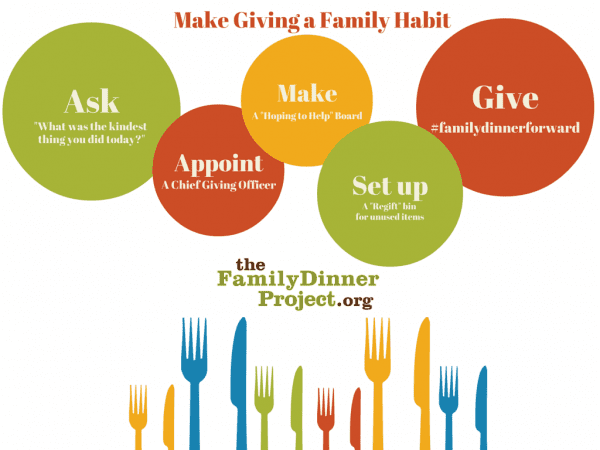In recent posts, we’ve covered a number of different aspects of giving – how to prepare your family for a meaningful giving experience, practicing giving within the family and finding actions you can undertake with both local and global impacts. As the “official” season of giving winds to a close and the New Year begins, it’s a perfect time to start planning to make the habit of giving to others one that outlasts a date range on the calendar and becomes a regular ritual in your home. After all, the many benefits of giving back can be felt at any time of year, even when the rest of the world seems to have moved on to other things.
Family dinnertime is a great opportunity to keep your giving habit strong. Whether you decide to use one family meal per month, one per week, or even a few minutes of your dinnertime each day to connect with one another about giving, spending time together at the table working on cultivating positive family habits can reinvigorate your relationships and infuse dinner with extra meaning. Try some of the ideas below to help make your dinnertime into giving time.
- Start the conversation.
Many families enjoy using a few set dinner conversation starters at their table. For example, the popular “Roses and Thorns” game is one that even the Obama family uses in the White House to get their daughters to open up each evening. To keep giving a priority in your family’s thoughts and experiences, try asking questions like “What was the kindest thing you did today?” or “Did you have a chance to help anyone today?” Asking these questions on a routine basis will not only get your dinner conversation flowing in a positive direction, but may also help plant the seeds that will blossom into a daily habit of kindness for each member of the family. - Practice “Regifting.”
While it’s common for families to purge their possessions once or twice a year to make room for new belongings, tackling the whole task at once can not only be stressful but can place undue pressure on family members to give large amounts of their things away or risk feeling as though they haven’t done enough. (This is especially true for younger children, who may really only feel that they want to donate one or two toys and can feel anxious or resistant to the prospect of “cleaning out” all at once.) Instead of setting one time each year for donating unneeded items, try adding a “Regift” box somewhere in your home, perhaps near the “Recycle” bin. Each time a family member finds an item they no longer want or need, place it in the “Regift” box. Each week or so, bring the box to the dinner table and ask every family member to help decide whether or not the items inside are suitable for donation, and where they might be donated to do the most good. Over time, you’ll not only reduce household clutter and waste, but instill the habit of viewing unwanted items as an opportunity to help others. - Make a “Hoping to Help” board.
Often, both children and adults will encounter situations throughout the day that bring on a desire to help in some way, whether it’s something as simple as wanting to help a friend who’s struggling with homework, or a more complex desire like wanting to find a way to help children in poverty or resolve an environmental issue. Encourage family members to regularly share some of the things they’re hoping to help with. Write or draw the answers on slips of paper and tack them up somewhere prominent in your home, adding newspaper clippings, photos or any other relevant items that might help your board looking fresh and inspiring.Then set aside part of your dinnertime each week or month to look at the board as a family and choose a few of the items to tackle. Brainstorm manageable solutions (a weekly homework “play date” to work with that struggling friend on tough assignments, or a family bake sale to raise funds to donate to the cause of your choice) and work together to turn your plans into action. - Add it to your chore chart.
Giving back to others should be more pleasurable than doing household chores, but it is also a serious responsibility. By treating it as a task that everyone in the family needs to help with regularly, you can establish giving as both a priority and a habit. Try making each family member “CGO” (Chief Giving Officer) for a week at a time as part of the rotation of duties in your home. The CGO’s job is to come to the dinner table each night with at least one giving idea to discuss, and to assign giving tasks to family members throughout the week. - Keep passing #familydinnerforward.
Pick one night each week or month to engage the whole family in a #familydinnerforward action. You might find someone in your community who would benefit from being invited to your home to share your meal, or you could make a double batch of whatever you’re cooking and deliver the extra portions to a neighbor in need. You could bake cookies to brighten someone’s day or gather at the dinner table to make a shopping list for items you can donate to a local soup kitchen. Whatever you choose, using family mealtimes as an opportunity to share what you have with others is an easy way to cultivate a habit of giving that lasts throughout the year.

